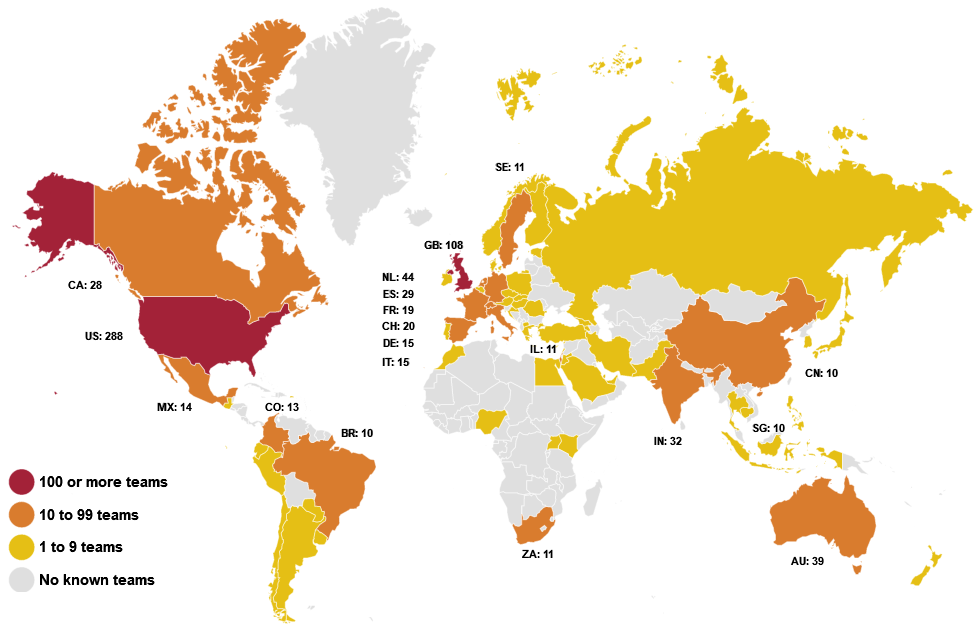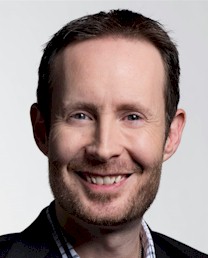By Steve Wendel
It’s hard to miss the rapid growth of our field: into new sectors, into new countries, and into new collaborations with other fields. Over the years, I’ve sought to better understand that growth by collecting data about our field and sharing the results. A few weeks ago, I launched the most recent effort – a survey for behavioral science & behavioral design practitioners and one for behavioral researchers around the globe. Here, I’ll share a bit about what we’re seeing so far in the data, and ask for your help to spread it more widely.
What We’re Seeing
First, our field has seen rapid growth since 2008 – which is, naturally, when Thaler and Sunstein’s Nudge first came out. The number of teams and practitioners in the space has grown more or less in tandem, though with a recent slowing in the creation of new teams since 2020. The most productive year was 2019, with 59 new teams starting; the subsequent three years have averaged 28 per year[1].
Behavioral science and design practitioners are also increasingly spread around the world. Just a few years ago, it was difficult to find practitioners outside of BeSci centers in the US, UK, and a few other countries. While we are still heavily concentrated in these areas, there are now active practitioners in 72 countries: from Paraguay to Senegal to Bhutan.

Figure 1: Where practitioners are located. Note – the live and interactive map is available on BehavioralTeams.com.
The majority of practitioners (52%) are in full-time behavioral science or behavioral design roles. The rest are working in other disciplines such as product design and marketing in which they aren’t dedicated to BeSci but have the opportunity to apply it in their work (38%). A minority of individuals have BeSci side jobs (9%).
Among respondents thus far, the most common challenge they are facing is making the case for behavioral science with senior leaders in their organizations (63%) and being able to measure the impact of their inventions (65%). Anecdotally, many practitioners in the field complain that they are asked for their recommendations on what to do, but aren’t given the opportunity to follow up and see if those recommendations were implemented or, when implemented, were actually effective.
The survey asks many more questions about the experiences and backgrounds of practitioners, but we’re still gathering data and will release new results when we have them.
How It Started: Behavioral Teams
If you’re curious about where all of this came from: I was writing a book on applied behavioral science in 2019 and wanted to better understand the growth of our field. The Action Design Network (ADN), Busara, the Applied Behavioral Science Association and I developed a survey of applied behavioral science teams, which we first published in 2019, and updated in 2020. In 2021, we started hosting a brief survey of practitioners but didn’t promote it.
It’s a volunteer side project, I got distracted by other things, and let the site sit for a couple of years. (My apologies to the many people who filled it out during that time – your info is finally in there!). With Busara and ADN’s help, we resuscitated the site, leading to 870 teams around the world currently being registered on the website. We’ve also built on that original, brief, practitioner survey, to create the new one that we’re asking your help on now.
Along the way, there are a few other similar efforts that have popped up and you should know about, such as Matt Wallaert and BeSci.io’s public directory of applied behavioral scientists, and Chiara Varazzani and the OECD’s list of government and policy-focused teams. In addition, ABSA and GAABS have their own internal research on our field (we partnered with ABSA on the first version of the Behavioral Teams survey), and are great organizations to check out if you haven’t already.
The Ask
So, here’s our request: Please complete the survey if you haven’t done so already. If you have, please send it to others. I’m not trying any behavioral techniques to encourage you to do it. This is just a simple ask from a colleague.
As a reminder, there are two versions[2]:
We are especially interested in researchers and practitioners in the “Global South” (outside of the US, EU, and other Western developed countries) – so that we can help promote their work and organizations.
By the way – the site is intentionally plain text. It has always been a small side project, and I didn’t want to claim that it was more than it was. It’s not authoritative, and it’s probably not even fully accurate. It’s not meant to show off excellent behavioral design. Instead, it’s simply meant to be useful to our community.
I hope that it will be useful for you and that you can take a moment to fill out the survey so that we all get a clearer picture of the growth of our field.
[1] On methods: the survey is fully voluntary, and distributed through existing contacts, so there is likely a bias towards well-established BeSci communities as in the US, UK and Netherlands. This data comes primarily for the results so far on the practitioner survey. As of this writing, the practitioner list has about 700 entries, 550 of whom have completed most of the details from survey (others came from a few other sources, before the survey was launched). It also includes some data from the directory of behavioral science & design teams, which has 874 entries.
[2] The line between the “practitioners” and “researchers” can certainly be blurry, but the latter is designed for people whose primary job is generating and publishing new knowledge about how the mind works and – in academic journals or otherwise. Not people who do content marketing (like I have in the past), blog posts about other people’s research, etc. Also, if you haven’t seen and completed it already, we’re maintaining the behavioral teams list again; you can complete it here.
This article was edited by Carina Müller

